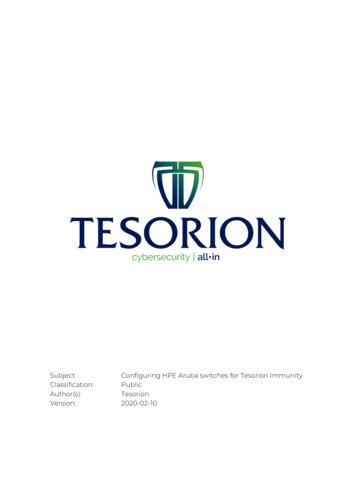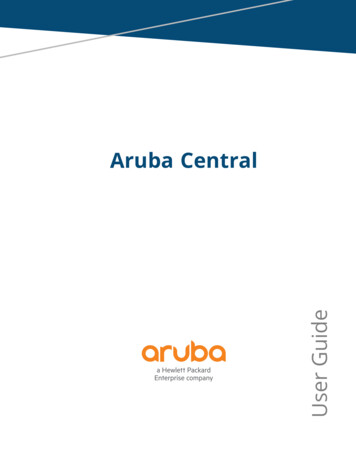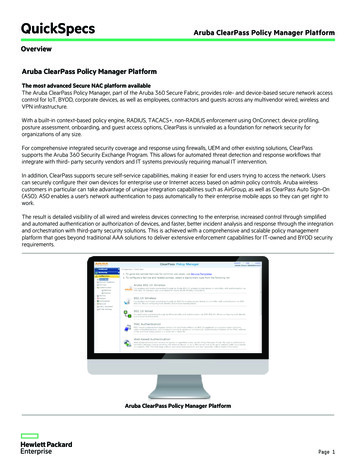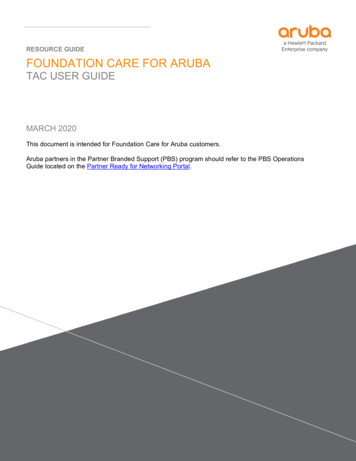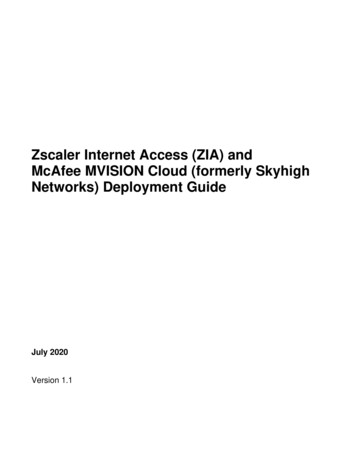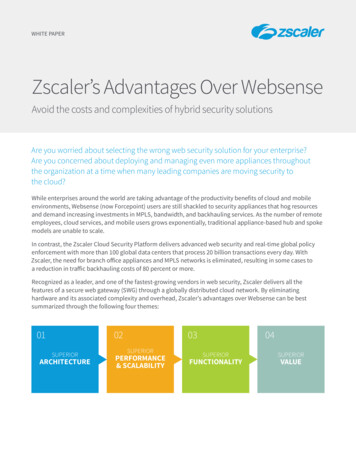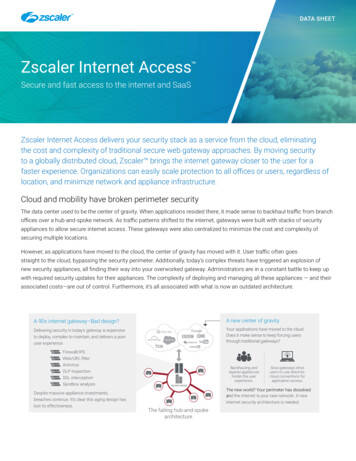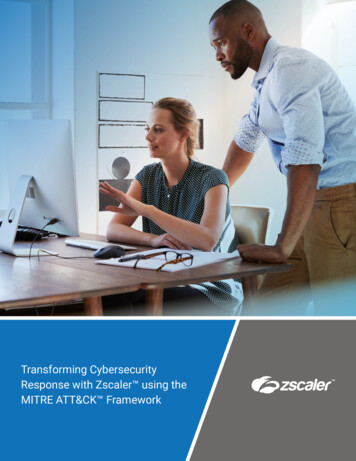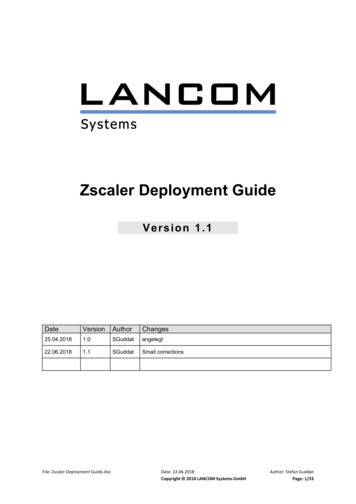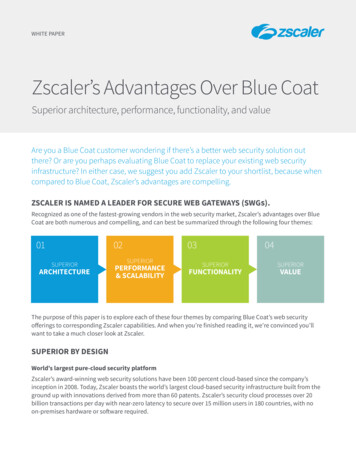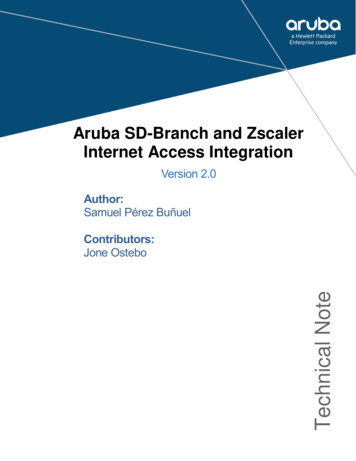
Transcription
Aruba SD-Branch and ZscalerInternet Access IntegrationVersion 2.0Author:Samuel Pérez BuñuelTechnical NoteContributors:Jone Ostebo
Copyright InformationCopyright 2019 Hewlett Packard Enterprise Development LP.Open Source CodeThis product includes code licensed under the GNU General Public License, the GNU Lesser General Public License, and/orcertain other open source licenses. A complete machine-readable copy of the source code corresponding to such code isavailable upon request. This offer is valid to anyone in receipt of this information and shall expire three years following the dateof the final distribution of this product version by Hewlett Packard Enterprise Company. To obtain such source code, send acheck or money order in the amount of US 10.00 to:Hewlett Packard Enterprise CompanyAttn: General Counsel6280 America Center DriveSan Jose, CA 95002USAwww.arubanetworks.com3333 Scott BlvdSanta Clara, CA 95054Phone: 1-800-WIFI-LAN ( 800-943-4526)Fax 408.227.4550
ContentsContentsRevision History . 4Introduction—Security in Aruba SD-Branch . 5Security layers .6ZIA Integration Overview . 7Tunnel establishment.8Policy-Based Routing .10Reference Architectures . 11Branch Gateways to ZIA .11Headend Gateway (VPNC) to ZIA .13Redundancy of ZIA nodes .14Branch Gateway Redundancy.15Configuration Workflows . 16Tunnel establishment.16Policy-Based Routing .23Verification Steps . 26Aruba SD-Branch and Zscaler Internet Access IntegrationContents 3
1 Revision HistoryRevision HistoryThe following table lists the revisions of this document:V e r s io nDateMo d if ie d B yC o m m e nt s2.02019-07-25Samuel Pérez BuñuelAdded Orchestrated workflow and reference architectures1.12018-10-18Samuel Pérez BuñuelUpdated configuration screenshots1.02018-07-17Samuel Pérez BuñuelInitial versionTable 1 - Revision historyAruba SD-Branch and Zscaler Internet Access IntegrationRevision History 4
2 Introduction — Security in Aruba SD-BranchSecurity is an integral part of the Aruba SD-Branch solution. First and foremost, because the solution is builtfrom the ground up to be completely policy-driven (or, in Aruba terms, role-based). Secondly, because ofthe fact that in most cases branches will be directly exposed to the Internet, which will require very robusthardening policies. And lastly, due to the firm belief that “best -of-breed” security should also be built aroundbranch networks.The security of the Aruba SD-Branch solution is built in layers, from the hardening of the operating systemto the integration with best-of-breed security partners.Figure 1 - SD-Branch Security LayersAruba SD-Branch and Zscaler Internet Access IntegrationIntroduction — Security in Aruba SD-Branch 5
2.1 Security layersFirst of all, the Aruba Gateways use ArubaOS, which is a tightly hardened platform, as the operatingsystem. This includes: Secure boot; TPM signed software image. Heavily restricting communications until the Gateway hasreceived its configuration from Aruba Central. Secure Zero Touch Provisioning; Leveraging the TPM loaded in the Aruba Gateways to securecommunications with Aruba Central. AES 256 encryption for all branch-hub tunnels. Aruba Role-based Stateful firewall; With support for scalable configuration using firewall aliases, ALGs,and role-based policies. Deep Packet Inspection module with capacity to identify close to 3200 applications. Web content and reputation filtering; using WebRoot’s machine learning technology to classify content,reputation, and geolocation for billions of URLs.Secondly, the Aruba SD-Branch solution can integrate with ClearPass (or other AAA servers) to f orm a truepolicy-driven branch. This model dynamically assigns policies based on users and devices, as opposed tothe traditional way of assigning these policies manually based on ports, VLANs and IP addresses. Thispolicy-driven branch can be enhanced by leveraging integrations with the 140 partners in the 360 Secureexchange program. And it can be pushed even further by integrating with Aruba Introspect for User Entityand Behavioral Analytics (UEBA).Lastly, the Aruba SD-Branch solution can integrate with best-of-breed third-party security infrastructurepartners. With these integrations, the Aruba SD-Branch architecture seeks to offer enterprise-gradeadvanced threat protection in a scalable manner. With this in mind, the integration with Zscaler’s Securityas a Service offering, provides an extremely simple and scalable solution for advanced threatprotection in branch networks.Aruba SD-Branch and Zscaler Internet Access IntegrationIntroduction — Security in Aruba SD-Branch 6
3 ZIA Integration OverviewA common network architecture today is to tunnel traffic between a HQ and branches over either M PLS ordedicated encrypted VPN links. As more and more services are cloud -based, and more information isavailable on the internet, it makes less sense to tunnel traffic back to a central point before reaching itsendpoint.Breaking out traffic locally from the branches (as opposed to an on-premises appliance in the Data Center)allows traffic to reach its destination faster and use bandwidth more efficiently. However, allowing trafficdirectly between devices in the branch and the Internet may introduce security risks.To secure this traffic, the Aruba Branch Gateway (BGW) can redirect selected traffic through a cloud -basedsecurity platform such as the Zscaler Internet Access (ZIA) service. This enables best-of-breed security,with services like advanced threat protection or Data Loss Prevention (detailed information can be found inthe Zscaler documentation) without the need to increase the footprint in branch locations.INTERNETDC/HQAdvanced Threat ProtectionSP -1SP -2BranchFigure 2 — SD-Branch integration with Zscaler Cloud Security InfrastructureAruba SD-Branch and Zscaler Internet Access IntegrationZIA Integration Overview 7
3.1 Tunnel establishmentThe Zscaler security as a service suite is delivered by a next-generation security architecture built from theground up for performance and scalability. It is a three tiered platform with differentiated control plane(Zscaler Central Authority), data plane (Zscaler Enforcement Nodes) and loggi ng/statistics plane (ZscalerNanolog Servers). It is distributed across more than 100 data centers on 6 continents, which means thatusers are always a short hop away from their applications (source: Zscaler).Zscaler Internet Access is a secure Internet and web gateway delivered as a service from the cloud. Tointegrate with this service, all the SD-WAN solution needs to do is establish tunnels with the nearest ZIAnode(s) to send Internet-bound traffic through them (source: Zscaler).Both Aruba as well as the ZIA service support establishing communication s through IPSec or GRE tunnels.The drawback of using GRE, however, is that tunnels won’t be able to traverse NAT boundaries, verycommon in branch environment. For this reason, this Technical Note will focus on the implementation basedon IPSec tunnels.3.1.1 Tunnel DetailsThe tunnels between the Aruba Branch Gateway and the Zscaler E nforcement Nodes (ZENs) use IPSecwith null encryption. This provides the ability to traverse NAT boundaries and leverage IKEv2 forauthentication, while at the same time limiting the overhead. All that would be required to bring up the tunnelsis to set up accounts in Zscaler for the Branch Gateways and have them authenticate themselves usingthem. Such tunnels can be established manually or by using the SD -WAN Orchestrator service available inthe Aruba SD-Branch solution.A summary of the tunnel characteristics is provided in the following table:Phase 1Phase enticationFQDN & PSKN/AKey Exchange MethodDiffie-HellmanDiffie-HellmanDiffie-Hellman Group22NAT-TransversalEnabledN/ADead Peer Detection (DPD)EnabledPerfect Forward Secrecy (PFS)N/ADisabledMaximum Transmission Unit (MTU)N/A1460 BytesMaximum Segment Size (MSS)N/A1388 BytesVPN TypeN/APolicy-based VPNTable 2 — Tunnel CharacteristicsAruba SD-Branch and Zscaler Internet Access IntegrationZIA Integration Overview 8
3.1.2 Tunnel OrchestrationAruba Gateways can be configured to bring up tunnels to the ZIA service manually. This requires creating“locations” (as well as unique VPN credentials) in the ZIA service for each branch site. It also requiresconfiguring the Aruba SD-WAN Gateways to bring up tunnels to the nearest ZEN nodes to send the trafficthrough them. In the case of large-scale deployments this can be a very labor-intensive task.This function is automated in the Aruba SD-Branch solution by SD-WAN Orchestrator. The Aruba SD-WANOrchestrator is a cloud-native, multi-tenant control plane that is included as part of Aruba Central to automateSD-WAN deployments. The benefit of the SD-WAN Orchestrator is that WAN links are automaticallydiscovered and tunnels and routes are orchestrated based on business and topological needs, such asmapping data centers to branch offices (more information can be found in the Aruba SD-WANdocumentation).In the context of the Zscaler integration, the SD-WAN Orchestrator has the role of negotiating the tunnelestablishment between Gateways and the nearest ZEN node. It does so by executing the following steps:1. Bind Aruba Gateways with the nearest ZEN nodes. The Orchestrator queries the ZIA service for thenearest node(s) for each SD-WAN Gateway based on the public IP address from which every branch isseen.2. Create “locations” in ZIA. The SD-WAN Orchestrator creates the “Locations” for all Gateways in theselected groups through the ZIA APIs. Unique VPN credentials are also created for each Gateway.3. Orchestrate tunnels. The SD-WAN Orchestrator instructs each Gateway to establish tunnels with thenearest ZEN nodes using the credentials negotiated in step 2.Figure 3 — Orchestrated TunnelsAruba SD-Branch and Zscaler Internet Access IntegrationZIA Integration Overview 9
3.2 Policy-Based RoutingOnce the tunnels are established, the next step would be to make sure the relevant traffic is sent throughthese tunnels. The Aruba SD-Branch solution uses policy-based routing (or role-based routing) to determinewhich traffic flows are to be sent through the ZIA service.The following parameters can be taken into consideration when determining traffic types to be sent throughthe ZIA service: VLAN/User Role; PBR policies can be applied to roles or VLANs Stateful Firewall attributes; Protocol, Source/destination address, source/destination port FQDN; ArubaOS supports creating “netservices” based on FQDN, which can be used to build PBRpolicies.The following figure illustrates how Aruba Gateways selectively redirect traffic to ZIA; In this example,cameras are full-tunneled to the DC, Guest is sent directly to the Internet, and Employees/IoT are sent tothe Internet through the ZIA service with the exception of specific well-known SaaS applications.Figure 4 - Role-based routing policiesAruba SD-Branch and Zscaler Internet Access IntegrationZIA Integration Overview 10
4 Reference ArchitecturesThe integration of Aruba SD-WAN and ZIA allows for a wide variety of scenarios. This section describes themost common ones, which are validated by the Aruba Solution Test team.4.1 Branch Gateways to ZIAAruba BGWs can establish tunnels to one or several ZEN nodes (which can be in different regions, as shownin the following figure) to secure user traffic going to public cloud services or to the Internet, thus providinghigh availability. The solution supports manually setting the destination ZEN node for each BGW . It alsoprovides the possibility of using the SD-WAN Orchestrator learn the closest node for each branch andautomatically establish the tunnels to it.Figure 5 - Tunnel to Nearest NodeAruba SD-Branch and Zscaler Internet Access IntegrationReference Architectures 11
4.1.1 Uplink Load-balancing and DPSAruba BGWs supports uplink load-balancing. All traffic that enters ZIA through a tunnel is guaranteed toreturn (egress) through the same tunnel. The ZIA architecture prevents any chance of asymmetrical routingwhen parallel tunnels are established. The Branch Gateway would simply set up a tunnel from every WANinterface.Moreover, the Aruba Branch Gateway is capable of selecting the WAN circuit to be used by each traffic flowbased on rich policies such as the ones built for PBR. The routing engine (global routing table or PBR)provides a set of “next-hops” and the DPS engine selects the optimal path. On top of that, the BranchGateway can monitor the different WAN circuits to steer traffic to the optimal path based on SLAs set foreach application.An example workflow would look like this: ClearPass (or another RADIUS server) assigns the role "PoS" to the device The firewall classifies the session as “Payment”. The routing for a PoS device using a “Payment” app states that the next-hop is a certain ZIA node, andthe paths are, for example: INET and LTE Because the traffic is classified as "Payment", it's handled by the DPS policy "Payment". This policy hasINET as preferred path, as well as an SLA that has to be met. If the measured values for INET meet the SLA for the “Payment” policy the session goes through thetunnel that's established using the INET uplink. If at any point in time the measured SLA for INET drops,the Gateway will steer it to any other active tunnel that’s meeting the SLA. If no circuit meets the SLA, thesystem will chose the one that deviates the least from the configured SLA.1User-Role: PoSEnterprise DCHeadend GatewayPath MetricPath MetricLTEINETMPLSLTE3INETNext-Hop:Tunnel ZEN-01Path: INET, ET1200ms54%60%LTE80ms102%5%2Path Mon Policy4Payment GWNameVoicePaymentGuestWAN PolicyLatency 100ms & Jitter 10 & Loss 2%& Util 70%Latency 150ms & Loss 50% & Util 90%Util 95%Figure 6 - Dynamic path steeringAruba SD-Branch and Zscaler Internet Access IntegrationReference Architectures 12
4.2 Headend Gateway (VPNC) to ZIAIt often happens that branch traffic is aggregated at a local hub and then routed to the Internet or to othercorporate resources. This case is especially common when using pr ivate WAN networks. In such scenarios,Aruba VPNCs can set up tunnels to the nearest ZEN node to have branch traffic go through additionalsecurity validations.Figure 7 - Tunnels from regional DCsBoth hardware as well as virtual (vGWs in private instances of Public Cloud) headend Gateways are supported in this model.Aruba SD-Branch and Zscaler Internet Access IntegrationReference Architectures 13
4.3 Redundancy of ZEN nodesAs shown in the section above, the load-balancing and Dynamic Path Selection mechanisms would takecare of WAN circuit redundancy. However, that may not be sufficient in the unlikely event that a ZEN nodewould become unavailable. In order to address that, the Aruba SD -Branch integration with Zscaler makesuse of the Dead Peer Detection (DPD) protocol to ensure the traffic doesn’t get blackholed.Zscaler DC 1Zscaler DC 2DPD KeepalivesSP -1SP -2BranchFigure 8 – Zen redundancyTunnels to redundant ZIA nodes are supported for both topologies displayed above; Branch Gateways to ZIA and HeadendGateways to ZIA.Aruba SD-Branch and Zscaler Internet Access IntegrationReference Architectures 14
4.4 Branch Gateway RedundancyWhen redundancy is required inside the branch, SD -WAN Gateways can share uplink interfaces with theirHA pairs. This is done by establishing a virtual uplink through the LAN to share such interfaces. The result,as shown in the image below, is that each Branch Gateway would have “physical” uplinks as well as “virtual”uplinks.Figure 9 - Branch HAIn a scenario like this, each Branch Gateway establishes tunnels to the ZIA service through all uplinkinterfaces (physical and virtual). Both BGWs can be defined in ZIA as a single “Location” and use the sameVPN credentials, or as 2 “Locations” with different credentials for each Gateway. Both operating modes aresupported.Figure 10 - ZIA tunnels with Branch HAAruba SD-Branch and Zscaler Internet Access IntegrationReference Architectures 15
5 Configuration Workflows5.1 Tunnel establishmentThe integration between Aruba and ZIA can be manually configured or it can leverage the SD -WANOrchestrator to streamline the process of creating “Locations” and VPN credentials in the ZIA service, aswell as bringing up the tunnels in the BGWs.5.1.1 Orchestrated Tunnel EstablishmentAs mentioned above, the integration between Aruba SD-Branch and the ZIA service can make use of the SDWANOrchestrator to automate large distributed deployments. The following configuration steps should be followed:5.1.1.1 Configuring ZIA for API accessNo “Locations” or VPN credentials have to be created in the Zscaler portal in the automated workflow, as the SDWAN Orchestrator does this through the API. For that to happen, the SD-WAN Orchestrator will need “partner”access to communicate through the API.To add a partner key for Aruba SD-Branch, complete the following steps:1. Log in to the Zscaler admin portal.2. Click Administration Partner Integrations SD-WAN in the Partner Integrations page in the ZIAportal.Click Add Partner Key. Create a Partner Key.Figure 11 - Create Partner API KeyAruba SD-Branch and Zscaler Internet Access IntegrationConfiguration Workflows 16
3. Create a Partner Administrator Role to provide credentials for the API access. This is done fromAdministration Role Management:Figure 12 - Create Partner Role4. Create a partner account for the SD-WAN Orchestrator. This can be done from Administration Administrator Management:Figure 13 - Create partner accountAruba SD-Branch and Zscaler Internet Access IntegrationConfiguration Workflows 17
5.1.1.2 Configuring Aruba SD-WAN for Orchestrated Tunnels1. To enable orchestration of tunnels, enter the partner credentials and API Key for the SD-WANOrchestrator to communicate to the ZIA service. This can be configured from Global Settings SDWAN Cloud Security.Figure 14 – Enable Automatic establishment of tunnels to ZIA service2. Then, select the Gateway groups that will establish tunnels to the ZIA service.Figure 15 - Select Groups to tunnel to ZIAAfter you enable the Orchestrated Zscaler integration in Aruba Central, the SD-WAN Orchestrator willinstruct the Gateways to establish tunnels to all ZIA nodes from all public WAN interfaces.INET, MetroE and LTE are considered public, while MPLS is considered private.The minimum ArubaOS version required for the Zscaler Orchestrated tunnels is 8.4.0.0-1.
Jul 17, 2018 · Aruba BGWs can establish tunnels to one or several ZEN nodes (which can be in different regions, as shown in the following figure) to secure user traffic going to public cloud services or to the Internet, thus providing . 4.1.1 Uplink Load-balancing and DPS Aruba BGWs supports uplink load

